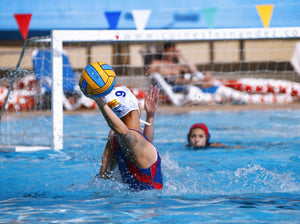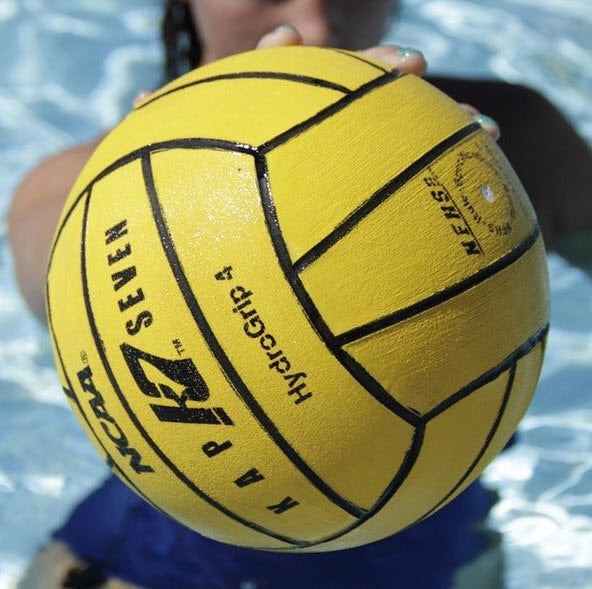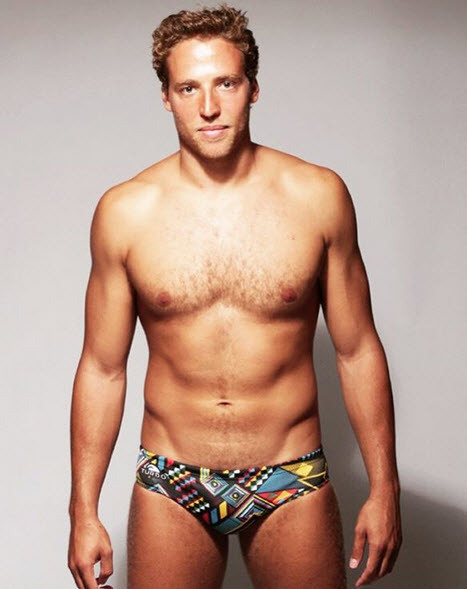Water Polo Goalkeepers: How to Adapt to Different Shots
 The most common shot is an overhand throw from a field player facing the goal, but that is hardly the only way to shoot a water polo ball. Goalkeepers need to know how to change their position in the goal, as well as how to change their physical approach to blocking a wide variety of shots. This guide explains the different types of shots goalkeepers can expect and how they can best protect the cage from each of them.
The most common shot is an overhand throw from a field player facing the goal, but that is hardly the only way to shoot a water polo ball. Goalkeepers need to know how to change their position in the goal, as well as how to change their physical approach to blocking a wide variety of shots. This guide explains the different types of shots goalkeepers can expect and how they can best protect the cage from each of them.
Skip Shots
A skip shot bounces off the surface of the water, which makes it very challenging to predict the ball's path. While it looks like a regular shot initially, the skip shot shooter actually aims the ball at the water a few feet in front of them and — with the right velocity — skips it into the goal. The body motions for this shot are slightly different from a standard overhead throw, so look for the shooter to come higher out of the water and to release the ball later. Because the ball is literally bouncing off the surface of the water, it usually goes to a high corner.
Sweep Shots
During a sweep shot, the shooter’s arm stays extended and parallel to the water as they turn and “sweep” the ball over the surface before releasing it into the goal. These shots are usually intended for the high corners of the cage, so goalkeepers should follow the path of the ball with their eyes as they get ready to lunge high to the right or left. This shot often comes from a hole set who is being guarded heavily to one side.
Wet Shots
Wet shots are taken off the surface of the water as the shooter is swimming toward the goal. They include the tee shot, screw shot, and shove shot. Most shooters taking a wet shot wait until they are quite close to the cage to release the ball. Goalkeepers can improve their odds of making a save by treading out toward the shooter to close down their angle. The ball will probably stay close to the water, so goalkeepers should block it with their chest and quickly protect it from the still nearby shooter.
Sometimes after a shot on goal, an offensive player will fight the goalie for possession of the ball. Goalies should swim the ball away from the goal quickly — to the side, not into the field of play — and with high elbows to protect it in these situations.
Backhand Shots
Usually taken close to the cage, backhand shots are fired when the shooter is facing away from the goal. The shooter will grip the ball between their hand and forearm, and raise their elbow before shooting. This shot comes most often from the hole set against a weak defender.
Lob Shots
Lob shots are slow, arcing shots intended to fall over the goalie and into a far corner of the cage. To block a lob, be patient. A goalkeeper who pops up too early is exactly what the lob shooter wants. Wait to see where it will fall and scoop it out of the goal. Lobs should be easy to control after they have been blocked since the ball is traveling at a fairly slow speed.
Five-meter Shots
These penalty shots are taken from the five-meter line. The shooter must face the cage and shoot the ball in one continuous motion after a tweet from the referee. The goalkeeper must be in the goal with their hips on the goal line before the whistle is blown. Some goalies like to predict a side for the shot and position themselves to lunge that direction. Others try to direct the placement of the shot by starting far to one side of the cage. Skip shots are one way shooters try to catch goalkeepers off guard, so watch out for the body position that comes before a skip shot.
Fake Shots
Many players will fake a shot or “pump fake” in an attempt to throw the goalkeeper off. The better the player, the more convincing their fake will be. Many players’ fakes are weak versions of what a shot should look like and it will be clear that a shot is not imminent. Goalkeepers need to quickly recover their body position quickly if a fake does throw them off.
No Two Shots Are the Same
It’s impossible for a goalkeeper to accurately predict every type of shot, and every field player has their own style of shooting. The best goalkeepers practice blocking a wide variety of shooting techniques, but never forget the importance of basics like body position, shooting angle, and controlling the ball after the shot. The more goalkeepers work on the specific techniques above in practice, the more automatic they will be in a game.



